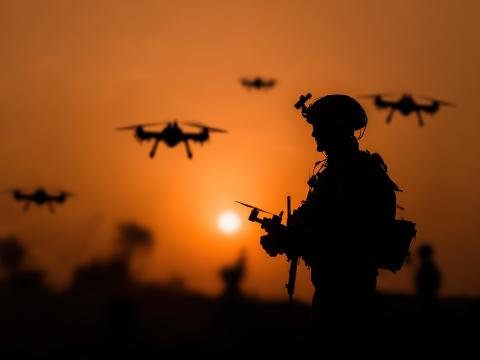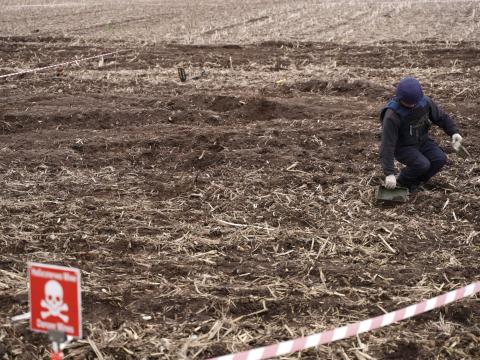Multinational Communications Capabilities Move Forward
Event reveals challenges that lie ahead in coalition environments.
Warfighters may experience some frustration as well as exhilaration in the network-centric environment. Today’s multinational exploration of emerging technologies has uncovered some new challenges that military forces face as they push the envelope on new capabilities. More than a decade of systematically examining technical interoperability issues has led to smoother execution of the technology demonstration and maturation process and realistic expectations on the part of both industry and the military.
Since the late 1980s, the Joint Warrior Interoperability Demonstration (JWID) has been the premiere platform for companies to display solutions for the armed forces. In response to a changing world, the event has evolved during the past several years. Initially, the services sought technologies that showed potential. Later, they were interested in capabilities that were mature enough to be pursued then inserted into the field. During this decade, the two goals have merged, producing a focus on solutions that address current and emerging challenges.
This is the first year that the event was sponsored by the Defense Information Systems Agency (DISA) rather than one of the services. Current plans are for DISA to continue to sponsor the event (SIGNAL, May, page 51).
With a theme of “Coalition Interoperability, the 21st Century Warfighter’s Environment,” JWID 2003 focused on defining solutions to interoperability issues, ensuring that those solutions can be applied to the operational community and enabling a standard solution for information sharing between coalition partners. Participants were pleased by some aspects of the event and somewhat surprised by others.
Because this was the second consecutive year that U.S. Pacific Command (PACOM), Camp H.M. Smith, Hawaii, hosted the event, Lt. Cmdr. Michael G. Ward, USN, operations officer, JWID Joint Management Office, Hampton, Virginia, says that experienced personnel helped the event proceed more smoothly from a technical standpoint. The complexity of the network configuration was one of the biggest success stories in JWID 2003, he adds.
To address the complicated information-sharing issue, two domains were set up within the network. The United States, Canada, United Kingdom, Australia, New Zealand and NATO made up the 6 Eyes environment. Through the use of technical guards and sharing protocols, Japan, South Korea, Singapore and Thailand were added, creating the 10 Eyes domain.
This represented a significant change from last year’s event when the Pacific Rim nations attended as observers. Capt. Christopher G. Fennig, USN, JWID 2003 multinational task force commander, operated in the 10 Eyes environment. Because the new participating nations could add information to the network, the common operational picture was more heavily populated with information, and relevant targeting information could be shared.
Setting up the dual domain, however, had its challenges that, in turn, produced valuable lessons. Cmdr. Ward relates that collaborative planning worked well in each environment, but unexpected difficulties arose when the countries in each domain tried to communicate with each other. For example, to guard sensitive information in a system intended to facilitate information sharing between the two domains, filters searched for words such as secret, classified or other terms with similar meanings. If a slide in a PowerPoint presentation included one of these terms, it would be stopped. In addition, when files were formatted in certain ways, such as .bmp, the message would not go through.
“Some of that was invisible to the warfighters because they would use a template that had a .bmp graphic on it, and that would stop the whole slide from going through,” the commander explains. “So we learned that we need to put together a list of things that can’t get through.” To address this problem during JWID, engineers had to troubleshoot individual messages, he adds.
Capt. Fennig relates that from a warfighter’s perspective, this was frustrating. Commanders used e-mail to create near-real-time task orders, but the blocked PowerPoint slides included necessary information, so planning sessions were delayed. Using this technology tactically could be very valuable to the warfighter if the pitfalls can be avoided. More importantly, if a file is returned, immediate analysis is needed, he says.
The event featured more than 40 coalition interoperability trials (CITs) that addressed several categories of technologies. Two types of capabilities particularly interested Cmdr. Ward and many of the visitors to the PACOM site. Demonstrations that addressed the issues of language translation and blue force tracking caught the commander’s eye, particularly in light of recent operations in Iraq.
Because JWID 2003 focused on the coalition environment and not just the joint domain, the JWID team had to overcome the language barrier. Several CITs offered approaches that allow troops speaking different languages to communicate. Cmdr. Ward notes that understanding a foreign language is not just a skill, it is an art, and it involves more than word-for-word translation because phrases can be interpreted in several ways.
“The challenge in any translation tool is that it must be able to capture that. For example, in English, we would say ‘a military operation.’ The strict translation of that, say in Spanish, would be operación de militar. But the strict translation to someone in Spain would be as some kind of medical operation in a military environment, and that could cause a lot of confusion,” he offers. Building the dictionaries and databases to address this quandary has been a problem. Cmdr. Ward says that JWID 2002 included work in this area that yielded improvements this year.
In addition, although tools exist that translate one language into another, often words and expressions must be shared in a variety of languages. Although this problem has not yet been solved completely, the commander says progress has been made in this area. For instance, the Text Simultaneous Machine Translation suite facilitates on-the-fly translations for instant messaging, chat sessions and PowerPoint slides. The CIT allowed machine translation in Japanese, Korean, Malaysian, Mandarin Chinese and Thai.
Another trial conducted at JWID involved tracking the movement of friendly forces. Cmdr. Ward explains that in the past, a warfighter had to carry a box that weighed approximately 10 pounds. One demonstration at JWID 2003 combined global positioning system capability with a device the size of a personal digital assistant (PDA) that connected to an Iridium satellite telephone. This design reduced the size by one-third, yet the device retained the same capability, plus troops could send text messages to request supplies or fire support using the PDA.
Capt. Fennig found the quality and the relevance of this year’s CITs surprising and said that the trial technologies better matched PACOM’s warfighter objectives. For example, the Coalition Warfare Program demonstration, a dynamic coalition network and security solution for the Pacific theater of operations, addresses the issue of sharing multilevel-security data in a multinational environment.
Cmdr. Ward offers that the evolution of JWID each year has resulted in industry and the U.S. Defense Department gaining an appreciation of the event’s value. Quoting Col. Gary R. Bradley, USMC, who was the director of JWID 2002, the commander says, “‘JWID has moved out of the beauty pageant phase into a real venue where we can test and evaluate new and emerging technologies.’ I think industry understands that, since we don’t just pick one or two winners now; every one has the same potential,” he says.
Capt. Fennig, who has been involved in JWIDs since 1997, agrees. In previous years, when a limited number of demonstrations were chosen for further development, the Defense Department’s management of the event did not offer the right incentive for companies to participate. Today, in light of the services’ transformation efforts, both the military and the commercial sector are more willing to experiment with new technologies, he says.
Next year, when U.S. Northern Command (NORTHCOM) hosts the event, the captain believes the focus on homeland defense will encourage even more experimentation, adding that many of the findings of this year’s trials can be applied to homeland security efforts. This is an example of how JWID has evolved during the past several years, he says. It has moved from a focus on the joint to the coalition environment. In the future, it will move to the federal government security arena, and these organizations will address interoperability issues in the policy, process and technology realms, he offers.
Although NORTHCOM was not one of the JWID sites this year, representatives from the command observed. Cmdr. Ward explains that NORTHCOM brings with it homeland security and homeland defense issues that have not been examined in a real-world context. One of the command’s goals will be to build the tactics, techniques and procedures, infrastructure and concepts of operations so that in an emergency the procedures already will be in place, he says.
This evolution from pure examination of technologies to the exploration of how they affect operations was evident in JWID 2003. Capt. Fennig observes that this year, industry realized that it is not enough just to bring a technology demonstration to the event. Companies also must present their ideas about training and concepts of operations. Although the Defense Department has indicated this requirement in the past, now the mandate is clear, he states.
The captain notes that at the close of JWID this year, several of the participating companies discovered that their proposed solutions should and could be combined to bring about an increased capability that is not achieved independently. One of the recommendations for next year is to conduct a tabletop conference prior to the event so participants learn of opportunities to combine solutions earlier in the process.
Even without the final evaluation report, Cmdr. Ward says he saw a number of technologies that he believes could be fielded within the next six to 12 months. “That’s my goal. Now that we have the results, we type up a nice fancy report, and we don’t want it to become ‘shelfware.’ How do we get it from shelfware to out-in-the-field-ware? That’s the big challenge,” the commander says. To accomplish this task, the results must be moved through the joint interoperability testing process to determine which products can be fielded within the next year.
The growing dependence on technology in operations is increasing the importance of events like JWID, Capt. Fennig points out. The military will not go to war without cross-domain tools, and the future order of battle will include coalition partners. The number of multinational events such as JWID may need to be increased to allow nations to examine their systems and ensure that information can be shared, he says.




Comments